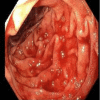Dieulafoy's Lesion of the Duodenum: A Rare and Fatal Cause of Gastrointestinal Bleed
- PMID: 37425531
- PMCID: PMC10324985
- DOI: 10.7759/cureus.40050
Dieulafoy's Lesion of the Duodenum: A Rare and Fatal Cause of Gastrointestinal Bleed
Abstract
Dieulafoy's lesion (DL) is an unusual cause of recurrent gastrointestinal bleeding that can be fatal. It can occur in various parts of the gastrointestinal (GI) tract, most commonly located in the stomach, especially at the level of lesser curvature; however, it can occur in other parts, including the colon, esophagus, and duodenum. A duodenal Dieulafoy lesion is characterized by the presence of a larger-caliber artery that protrudes through the GI mucosa and can lead to massive hemorrhage. The exact cause of DL is yet to be determined. Clinical presentation includes painless upper GI bleeding, including melena, hematochezia, and hematemesis, or rarely iron deficiency anemia (IDA); however, most of the patients are asymptomatic. Some patients also have non-gastrointestinal comorbidities such as hypertension, diabetes, and chronic kidney disease (CKD). The diagnosis is established by esophagogastroduodenoscopy (EGD), which includes the presence of micro pulsatile streaming from a mucosal defect, the appearance of a fresh, densely adherent clot with a narrow point of attachment to a minute mucosal defect, and the visualization of a protruding vessel with or without bleeding. Initial EGD can be non-diagnostic due to the relatively small size of the lesion. Other diagnostic modalities include endoscopic ultrasound and mesenteric angiography. The treatment of duodenal DL includes thermal electrocoagulation, local epinephrine injection, sclerotherapy, banding, and hemoclipping. We present here a case of a 71-year-old female who had a history of severe IDA requiring multiple blood transfusions and intravenous iron in the past and was found to have duodenal DL.
Keywords: acute gastrointestinal bleeding; dieulafoy’s ulcer; duodenal dieulafoy’s disease; extragastric dieulafoy's lesion; extragastric location of dieulafoy's lesion.
Copyright © 2023, Qasim et al.
Conflict of interest statement
The authors have declared that no competing interests exist.
Figures
Similar articles
-
A Rare Cause of Recurrent Lower Gastrointestinal Bleed: Colonic Dieulafoy's Lesion.Cureus. 2021 Dec 13;13(12):e20384. doi: 10.7759/cureus.20384. eCollection 2021 Dec. Cureus. 2021. PMID: 35036215 Free PMC article.
-
Upper gastrointestinal bleeding due to Dieulafoy's lesion of the stomach: a rare case report.EXCLI J. 2023 Aug 17;22:862-866. doi: 10.17179/excli2023-6407. eCollection 2023. EXCLI J. 2023. PMID: 37780938 Free PMC article.
-
Gastrointestinal Bleeding from Dieulafoy's Lesion in the Cecum.Case Rep Gastroenterol. 2022 Nov 8;16(3):601-606. doi: 10.1159/000525740. eCollection 2022 Sep-Dec. Case Rep Gastroenterol. 2022. PMID: 36636361 Free PMC article.
-
Dieulafoy's Lesion in the Esophagus Causing Gastrointestinal Bleeding: A Concise Review.J Community Hosp Intern Med Perspect. 2024 Nov 2;14(6):82-88. doi: 10.55729/2000-9666.1425. eCollection 2024. J Community Hosp Intern Med Perspect. 2024. PMID: 39839160 Free PMC article. Review.
-
Gastrointestinal bleeding from Dieulafoy's lesion: Clinical presentation, endoscopic findings, and endoscopic therapy.World J Gastrointest Endosc. 2015 Apr 16;7(4):295-307. doi: 10.4253/wjge.v7.i4.295. World J Gastrointest Endosc. 2015. PMID: 25901208 Free PMC article. Review.
Cited by
-
Dieulafoy's Lesion: A Rare and Elusive Cause of Massive Upper Gastrointestinal Bleeding Managed With Endoscopic Therapy.Cureus. 2025 Jan 9;17(1):e77206. doi: 10.7759/cureus.77206. eCollection 2025 Jan. Cureus. 2025. PMID: 39925567 Free PMC article.
-
The Silent Bleeder: A Case of Recurrent Hemorrhage From a Dieulafoy's Lesion.Cureus. 2025 Feb 14;17(2):e79000. doi: 10.7759/cureus.79000. eCollection 2025 Feb. Cureus. 2025. PMID: 40091976 Free PMC article.
-
Fatal exulceratio simplex (dieulafoy lesion) - a case report and review.Forensic Sci Med Pathol. 2025 Jun;21(2):1030-1035. doi: 10.1007/s12024-024-00895-4. Epub 2024 Sep 19. Forensic Sci Med Pathol. 2025. PMID: 39298100 Free PMC article. Review.
-
Complex Presentation of a Dieulafoy Lesion in a Geriatric Patient with Multiple Comorbidities.Cureus. 2023 Oct 30;15(10):e47985. doi: 10.7759/cureus.47985. eCollection 2023 Oct. Cureus. 2023. PMID: 38034218 Free PMC article.
References
-
- Duodenal and Jejunal Dieulafoy’s lesions: optimal management. 1]Yılmaz TU, Kozan R. https://www.tandfonline.com/doi/epdf/10.2147/CEG.S122784?needAccess=true... Clinical and Experimental Gastroenterology. 2017;7:275–283. - PMC - PubMed
-
- Dieulafoy’s lesion of the duodenum: the management of this unusual location. Rajae Bounour, Amal Mejait, Maria Lahlali. Cas Rep Clin Med. 2022;8:268–272.
-
- Dieulafoy's lesion. Lee YT, Walmsley RS, Leong RW, Sung JJ. https://pubmed.ncbi.nlm.nih.gov/12872092/ Gastrointest Endosc. 2003;58:236–243. - PubMed
-
- Recurrent massive haematemesis from Dieulafoy vascular malformations--a review of 101 cases. Veldhuyzen van Zanten SJ, Bartelsman JF, Schipper ME, Tytgat GN. https://gut.bmj.com/content/27/2/213. Gut. 1986;27:213–222. - PMC - PubMed
Publication types
LinkOut - more resources
Full Text Sources
Miscellaneous


